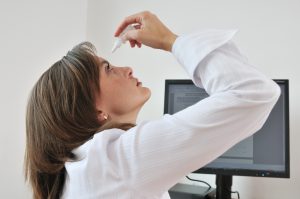 Dry eye syndrome is a chronic lack of sufficient lubrication and moisture on the surface of the eye. Its consequences range from subtle but constant irritation to ocular inflammation of the anterior (front) tissues of the eye. Dry eye syndrome is an ongoing condition that may not be completely curable (depending on the cause), but the accompanying dryness, scratchiness and burning can be managed.
Dry eye syndrome is a chronic lack of sufficient lubrication and moisture on the surface of the eye. Its consequences range from subtle but constant irritation to ocular inflammation of the anterior (front) tissues of the eye. Dry eye syndrome is an ongoing condition that may not be completely curable (depending on the cause), but the accompanying dryness, scratchiness and burning can be managed.
Dry eye syndrome (DES) is an eye disease caused by eye dryness, which, in turn, is caused by either decreased tear production or increased tear film evaporation.
Symptoms
Typical symptoms of dry eyes are dryness, burning and a sandy-gritty eye irritation that gets worse as the day goes on. Symptoms may also be described as itchy, scratchy, stingy or tired eyes. Other symptoms are pain, redness, a pulling sensation, and pressure behind the eye. There may be a feeling that something, such as a speck of dirt, is in the eye. The resultant damage to the eye surface increases discomfort and sensitivity to bright light. Both eyes usually are affected.
There may also be a stringy discharge from the eyes. Although it may seem strange, dry eye can cause the eyes to water. This can happen because the eyes are irritated. One may experience excessive tearing in the same way as one would if something got into the eye. These reflex tears will not necessarily make the eyes feel better. This is because they are the watery type that are produced in response to injury, irritation, or emotion. They do not have the lubricating qualities necessary to prevent dry eye.
Because blinking coats the eye with tears, symptoms are worsened by activities in which the rate of blinking is reduced due to prolonged use of the eyes. These activities include prolonged reading, computer usage, driving, or watching television. Symptoms increase in windy, dusty or smoky (including cigarette smoke) areas, in dry environments, high altitudes including airplanes, on days with low humidity, and in areas where an air conditioner (especially in a car), fan, heater, or even a hair dryer is being used. Symptoms reduce during cool, rainy, or foggy weather and in humid places, such as in the shower.
Most people who have dry eyes experience mild irritation with no long-term effects. However, if the condition is left untreated or becomes severe, it can produce complications that can cause eye damage, resulting in impaired vision or (rarely) in the loss of vision.
Symptom assessment is a key component of dry eye diagnosis – to the extent that many believe dry eye syndrome to be a symptom-based disease.
Treatment
A variety of approaches can be taken to treatment. These can be summarized as: avoidance of exacerbating factors, tear stimulation and supplementation, increasing tear retention, and eyelid cleansing and treatment of eye inflammation.
General measures
Dry eyes can be exacerbated by smokey environments, dust and air conditioning and by our natural tendency to reduce our blink rate when concentrating. Purposefully blinking, especially during computer use and resting tired eyes are basic steps that can be taken to minimize discomfort. Rubbing one’s eyes can irritate them further, so should be avoided. Conditions such as blepharitis can often co-exist and paying particular attention to cleaning the eyelids morning and night with mild shampoos and warm compresses can improve both conditions.
Environmental control
Dry, drafty environments and those with smoke and dust should be avoided. This includes avoiding hair dryers, heaters, air conditioners or fans, especially when these devices are directed toward the eyes. Wearing glasses or directing gaze downward, for example, by lowering computer screens can be helpful to protect the eyes when aggravating environmental factors cannot be avoided. Using a humidifier, especially in the winter, can help by adding moisture to the dry indoor air.
Rehydration
For mild and moderate cases, supplemental lubrication is the most important part of treatment.
Artificial tears
Application of artificial tears every few hours can provide temporary relief.
Additional options
Lubricating tear ointments can be used during the day, but they generally are used at bedtime due to poor vision after application. They contain white petrolatum, mineral oil, and similar lubricants. They serve as a lubricant and an emollient. Application requires pulling down the eyelid and applying a small amount (0.25 in) inside. Depending on the severity of the condition, it may be applied from every hour to just at bedtime. It should not be used with contact lenses. Specially designed glasses that form a moisture chamber around the eye may be used to create additional humidity.
Medication
Inflammation occurring in response to tears film hypertonicity can be suppressed by mild topical steroids or with topical immunosuppressants such as cyclosporin.
Fish consumption
and omega-3 fatty acids
Consumption of dark fleshed fish containing dietary omega-3 fatty acids is associated with a decreased incidence of dry eyes syndrome in women.
Restasis
Topical cyclosporin (topical cyclosporin A, tCSA) 0.05% ophthalmic emulsion is an immunosuppressant, marketed in the United States by Allergan under the trade name Restasis. Approved as a prescription product by the U.S. Food and Drug Administration in 2002, the drug decreases surface inflammation. Usually, 1 gtt (drop) of Restasis is instilled in each eye twice a day, 12 hours apart. It should not be used while wearing contact lenses, during eye infections or in people with a history of herpes virus infections.
Xiidra (liftegrast ophthalmic solution)5% is a prescription eye drop used to treat signs and symptoms of dry eye disease. FDA approved in 2016, it is the first prescription eye drop for both signs and symptoms of dry eye disease.
Tears
There are methods that allow both natural and artificial tears to stay longer.
Blocking tear drainage
In each eye, there are two puncta — little openings that drain tears into the tear ducts. There are methods to partially or completely close the tear ducts. This blocks the flow of tears into the nose, and thus more tears are available to the eyes.
Punctal plugs
Punctal plugs are inserted into the puncta to block tear drainage. For people who have not found dry eye relief with drugs, punctal plugs may help. They are reserved for people with moderate or severe dry eye when other medical treatment has not been adequate.
Surgery
In severe cases of keratoconjunctivitis sicca, tarsorrhaphy may be performed where the eyelids are partially sewn together. This reduces the palpebral fissure (eyelid separation), ideally leading to a reduction in tear evaporation.
From Wikipedia, the free encyclopedia
Disclaimer
This information is presented for education purposes, to make it easy for you to explore your vision correction options. HOWEVER, no matter how reliable information on this or any website may be, there is no substitute for a professional examination of your eyes and a face-to-face discussion of your unique situation. If you are experiencing any difficulty with your vision, you should schedule an eye examination.
